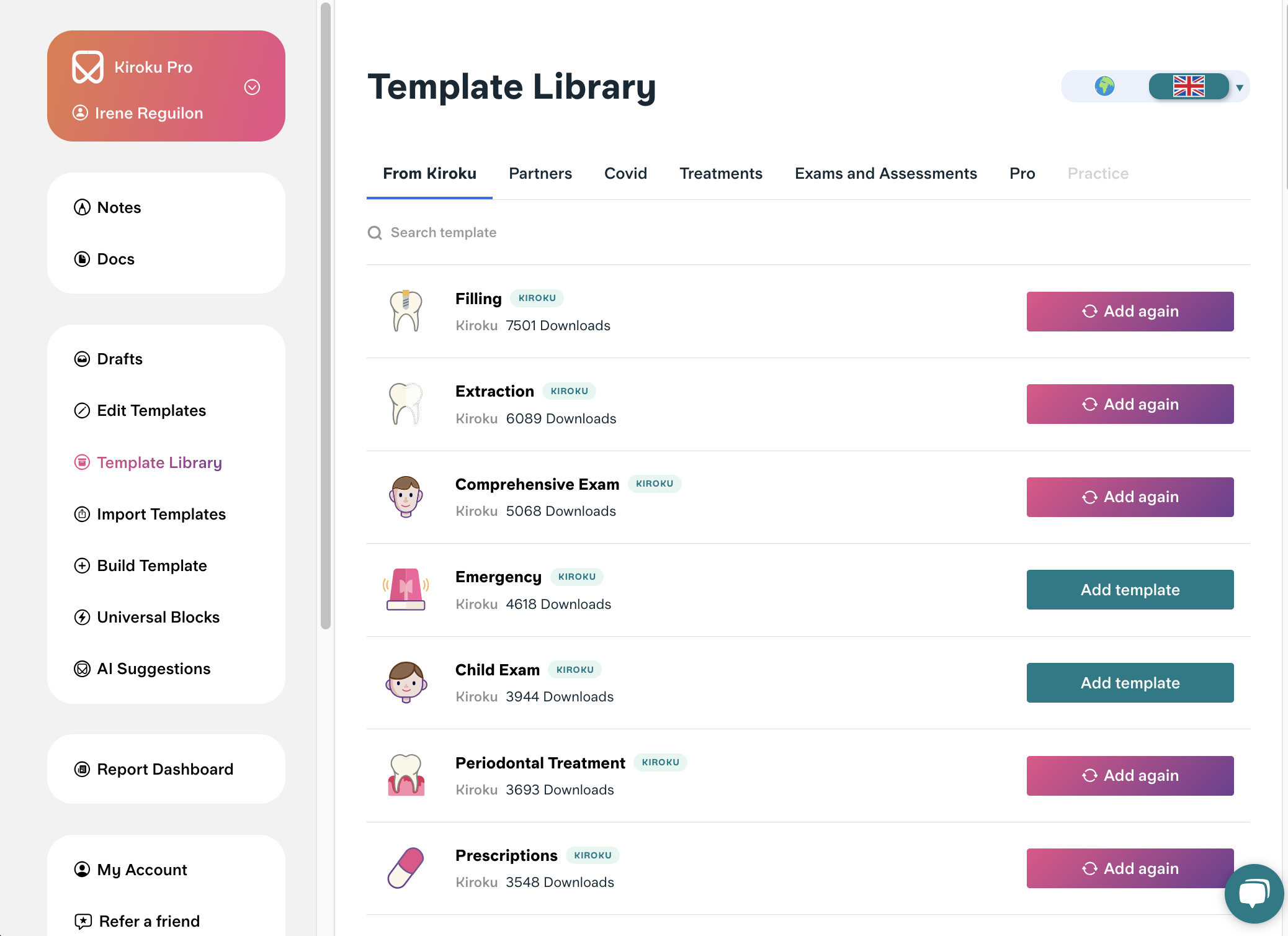Kiroku terminology
This useful guide gives you an overview of the features of Kiroku
Templates
A template is what you create your notes from. It describes one appointment type. Kiroku provides you with a library of stock templates but you can also create your own. Our templates are interactive and customisable to make note-taking faster.

Template Library
The template library is where all of the available Kiroku stock templates are stored. You can add as many stock templates to the template picker on your dashboard as you like.
Find out more about the Template Library.

Template Picker
The template picker on your dashboard(s) is where all of your templates live. These can be stock templates, modified templates, or templates you have created. When you want to start an appointment, you pick the relevant template from your template picker.
Hovering over individual templates in your template picker gives you options for managing your templates, such as renaming, editing or sharing them.

Appointments
An appointment is a completed set of Notes that has been created from one of your Templates. You complete appointments by clicking the ‘Copy notes’ button.
Find out more about completing appointments here.
Note Writer
The Note Writer screen is what you work in to take your notes, once you have picked a template to start an appointment. You can find out more about the key tools in our Creating Notes articles:
-
Copy Notes
-
Import Notes
-
View drafts / Save to Drafts
-
Section navigation

Template Editor
Every Kiroku template is customisable. Whether you added it from our Template Library, uploaded your own template or created it from scratch. With Kiroku, you can update your templates as you change your workflow.
Import Templates
Our clinical team will convert any existing templates that you have and turn them into clickable Kiroku templates. Simply upload your existing template and we'll do the rest!

Blocks
A block can take different formats: sections, text, button groups, multi-selects, drop-downs or selectors. You can have multiple blocks making up each note or line. For example, the below line has two text blocks and two button blocks.
Find out more about buttons here.

Sections
A section is one part of the template, usually grouping together lines of notes. Sections are big boxes and have a visible large and bolded title. When you export your notes, they are grouped by the section title, which is also included in your notes.
Section titles can be changed, and you can also copy individual sections of your notes.

Lines
Each line can contain different types of blocks. Lines of notes can be built into the template or can be added due to links.
Line header
A line header is the bold bit of text at the start of each line that indicates what the line is about. Line headers can be created by ending text in your text block with a colon (:) or question mark (?). Note that this only works if the very first block in your line is a text block, and won't work if you include a space at the end of your text block.
Universal Blocks
Universal Blocks are a special kind of block. They are perfect for information that you might need to update regularly, like medication batch numbers and expiry dates. When you update a Universal Block, it will update wherever it is used - no need to edit every single template!
Find out more about Universal Blocks.

Links
A link connects different lines of your notes together, regardless of where your note line is. Links help you to populate your notes with more detail and quickly.
Find out more about links here.

Linked lines
New notes are outputted by linked lines when a certain block is selected. These can either be below the note line that contains the trigger block or in other sections. Linked lines are how you populate more of your notes while writing less. Linked lines appear with a blue dot and a 'new' label next to them.

Drafts
A draft is an appointment that hasn’t yet been completed (the notes have not been copied to the clipboard). Your drafts can be saved (you have chosen to save them, adding patient initials for reference) or can be automatic backups of un-completed appointments.
Find out more about drafts here.

Docs 
With Kiroku, you can convert your Notes into any number of Docs - without needing to rewrite a thing. Simply click the appropriate Docs template to generate the document type you've chosen. Generate as many Docs as you need, and save or send them directly from within Kiroku with our Tracked Docs.

AI Suggestions
AI Suggestions are how your templates learn from you and adjust themselves to your style.
Kiroku’s AI learns from your behaviour during appointments, notices patterns, and offers up the learnings in the form of suggested edits. You can accept or reject these suggestions at the click of a button - leaving you with personalised templates with minimal effort.

Import Notes
You can copy sections from other templates without having to leave your current notes. Use the 'Import Notes button' to pick the template you want to copy from. Select the section(s) you want and finally select where you would like it to go into your notes.
Snippets
Snippets can add text or a long description to your notes. These are not built into your template but you may find you need to include them in the notes for your appointment.



